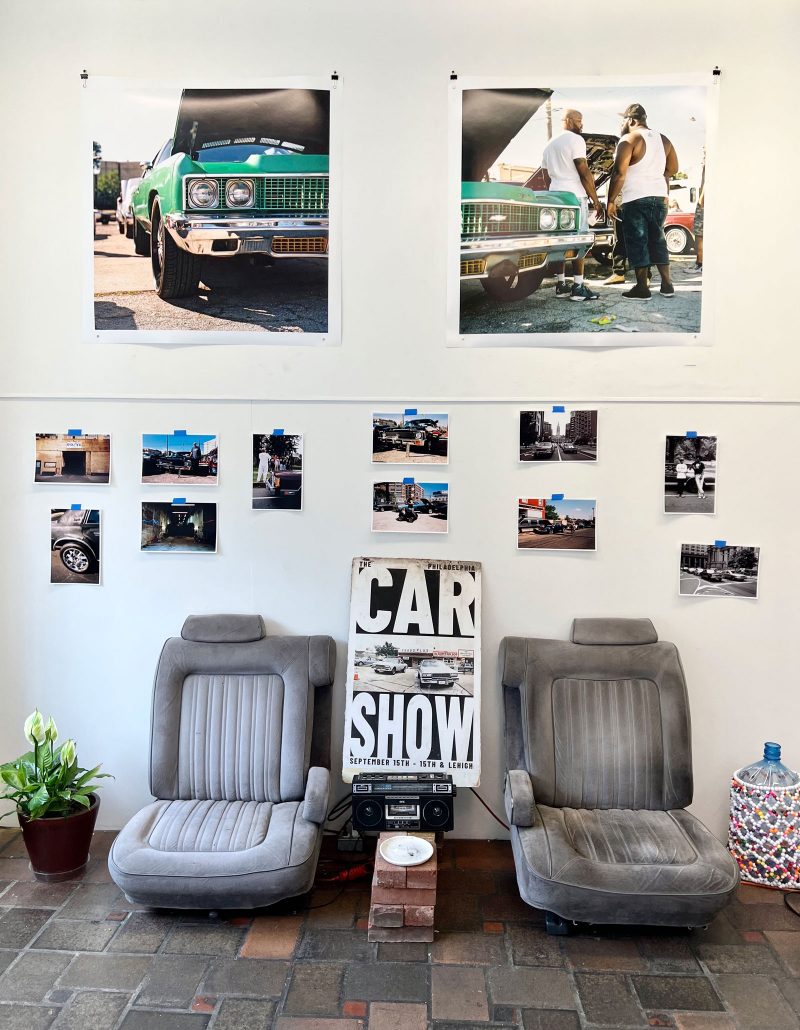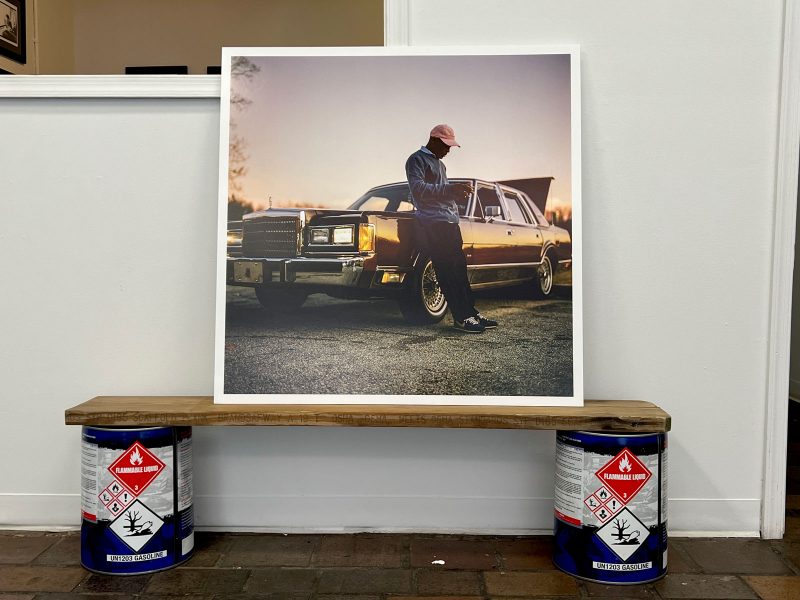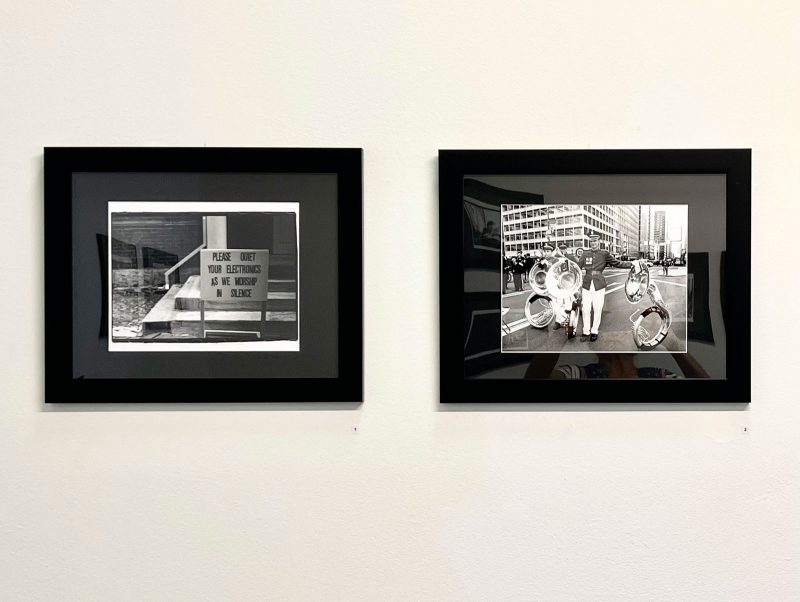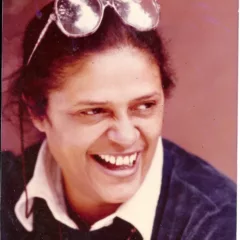
Right now, the iMPeRFeCT Gallery could, at a glance, be mistaken for an auto body shop. A tire and a can of racing fuel sit just inside the picture window facing Germantown Ave., and once you step inside, a shrine constructed from even more tires, sparkplugs, and oil jugs commands attention at the center of the room. These are the trappings of The Philadelphia Car Show, an exhibition of photographs of classic cars by Philadelphia-based artist Sheldon Omar-Abba, on view until July 16.
The exhibition, which also includes work by photographer Mateus Kaplan and ceramicist Ben Peterson, celebrates the 10-year anniversary of the gallery’s founding.
Renny Molenaar and Rocio Cabello, who have been my neighbors for many years, met in the 80s in the South Bronx, where Renny ran a gallery called Black and White in Color. They moved from New York to Philly in 2002 and started iMPeRFeCT Gallery in 2012, about a block away from where it is now.
Both working artists, Renny and Rocio wanted to establish a space in Germantown that approached art as a foundation for community and human-to-human joy, not as a bunch of objects to be bought, sold, and quietly observed.
When financial troubles threatened the gallery’s future in 2013, Renny told WHYY, “We don’t mount shows with the prospect of sales. We mount with a passion that we believe in.” [ED note: Roberta and Libby interviewed Rocio and Renny for an Artblog Radio podcast in 2014. Listen here.]
That ethos may have caused a cash shortage, but it cured it, too. Through their wide-ranging exhibitions and events, Renny and Rocio made iMPeRFeCT an indispensable part of the neighborhood, and when its survival was in the balance, donors from the community kept the gallery afloat. Following a year and a half of instability caused by Covid, Renny and Rocio set an “ambitious, maybe miraculous” goal of $20,000 for their year-end campaign. They reached it with plenty of time to spare.
The best representation of iMPeRFeCT’s generous spirit are the rumbas hosted weekly at the gallery. Described in an iMPeRFeCT Instagram post as “organic gatherings of percussionists and enthusiasts of different backgrounds and nationalities, all united by their love of this Cuban call and respond tradition,” the rumbas are not performances. During a rumba, everything is shared—food, drink, drums, the dance floor—and the distinction between performer and audience becomes meaningless; everyone is either moving or making music, and most people are doing both. That’s the nature of call and response: there are no passive observers.

Like the rumbas, Car Show tries to close the distance between the art and its viewers. To that end, Omar-Abba does away with frames entirely; most of his car photographs, shot on color film, are hung on the wall either by bits of blue painter’s tape or binder clips, and a few are scattered in the top of an open toolbox. When Rocio was preparing the gallery for the exhibition, Omar-Abba told her, “Don’t clean, don’t sweep, don’t mop—I want it dirty.”
Rather than making the space feel messy or chaotic, Omar-Abba’s DIY presentation—which, it’s clear, was still carefully considered—makes his work feel approachable. You could stick your nose right up to the prints and inspect the film grain without worrying about being barked at by a security guard. If you really wanted to, you could get on your hands and knees and sniff the inky black motor oil that, as part of the central sculptural shrine, has been decanted into a wide ceramic vessel. The gallery doesn’t just look like a car garage; it smells like one, too.
Omar-Abba’s photographs possess a raw, tough beauty in common with the cars they take as their subjects, many of which are box Chevys from the 70s and 80s. Models like the Impala or the Caprice were, and still are, everyday cars. Practical and relatively inexpensive, they’re the sort of thing a grandfather might drive to the pharmacy.
But Omar-Abba is interested in a subset of those cars with particularly loving owners who have given them sparkling paint jobs and polished their oversized rims to a mirror-like gleam. Not all of the cars photographed for the show are spotless, but they are all adored. Omar-Abba understands these feelings well: he owns a couple Caprices of his own and has organized several meet-ups for like-minded car enthusiasts.
Resting on a stack of tires in the middle of the room are a few crowbars. Further inspection reveals that they are not made from forged steel but rather glazed porcelain; Ben Peterson, the ceramic artist whose work is on display alongside Car Show, shares a studio space with Omar-Abba and helped him cast the sculptures.

The porcelain crowbars are a masterful touch. They reflect what’s so captivating about the photographs, but in even sharper focus: the shiny, delicate body housing a hardened metal soul. “Gritty but also beautiful,” as Renny described to me.
Omar-Abba’s ability to show that duality in each frame is evidence of impressive technical ability. Photographing a car well is like drawing a car well, which, as anyone who has tried will know, is not easy. But Omar-Abba has such familiarity with these forms—the elegant curves of chrome bumpers, the shimmer of paint in the sun—that, seen through his eyes, the cars seem nearly as alive as the people sitting behind their wheels and leaning against their hoods.
Some of the photographs have no humans in the frame, but most of the images at least hint at one. One of my favorites shows a scene unfolding in the six inches that are visible between the bottom of an open car door and the ground: a Jordan-clad foot steps out of the driver’s seat while another pair of shoes stands further back, behind a wheelchair that presumably belongs to the driver.
At the back of the gallery are several images made inside car shops. Groups of mechanics sit together, laughing and smoking under fluorescent lights. Shelves of tools and grease-covered towels remind you how much work it takes to keep these machines running. Car Show is a celebration of cars, first and foremost, but also of the Philadelphians who care for them.
In the GReaT GLaSS eLeVaToR, a small room within the gallery that is, as its name suggests, about the size of an elevator shaft, the work of another film photographer is on display. In anonymity, Mateus Kaplan exhibits a collection of black and white street photographs printed in a darkroom on silver gelatin paper.

Kaplan shares Omar-Abba’s technical sophistication—Renny described him affectionately as “a total geek” who is “enamored of technique, technology, and process”—but the similarities between the two photographers end there. For one, Kaplan eschews color, allowing more room to play with shadow and form. In one image, someone flexes, shirtless, for the camera. Silhouetted against a lighter background, their face and most of their body is hidden in shadow; only the edges of a few tattoos on their chest are lit by spots of sunlight.
Although certain forms repeat—disembodied hands, musical instruments—the photographs are mostly united by their perspective. Even in the few images that show subjects looking directly into the lens, there is a sense of Kaplan as an anonymous observer. Unlike the methodically framed portraits in Car Show, the photographs in anonymity feel fleeting—moments seen and remembered by no one but Kaplan’s camera.
The final exhibition space, the ReD RooM—also a functioning bathroom—is filled with pottery made by Peterson, the ceramicist who helped Omar-Abba cast the porcelain crowbars. His show is called Make Pottery Gay Again and includes a row of glazed mugs with phrases like “420,” “gay 666,” and “drugz” painted on. In the corner is a stack of dishware below a sign that reads, “Miscellaneous Plates and Bowls (without satanic gay stuff).”
The ReD RooM is the perfect space for Peterson’s pottery, which is enthusiastically filthy—a shelf holds a trio of sculptures depicting figures urinating on themselves with their legs held above their heads—but also intelligent and satirical, like a bit of wisdom you’d find scrawled in a public bathroom stall.
When I visited iMPeRFeCT to see the shows by Peterson, Kaplan, and Omar-Abba, it was June 23, 10 years to the day since the gallery’s founding. It was also dinner time, and Renny and Rocio were sharing a container of Jamaican takeout; despite the monumental occasion, at least in the life of this small but big-hearted Germantown gallery, they seemed more preoccupied with shrimp and rice than with nostalgia.
I asked Renny how it felt to look back on a decade. “It’s hysterical,” he told me, giggling. But then he got serious—uncharacteristically so. “When we realized the 10 was upon us, the logical thing was to memorialize,” Renny said. “But I wasn’t in a mood to look back. I wanted to look forward.”
iMPeRFeCT Gallery’s 10th Anniversary Exhibitions are on view June 4 – July 16, 2022; with an artist talk this Thursday, July 7th, 22, 7-9PM featuring all three exhibiting artists. Exhibitions include: “Sheldon Omar-Abba: The Philadelphia Car Show,” “Mateus Kaplan: anonymity” (in the GReaT GLaSS eLeVaToR), and “Ben Peterson: Make Pottery Gay Again” (in THe ReDRooM).









